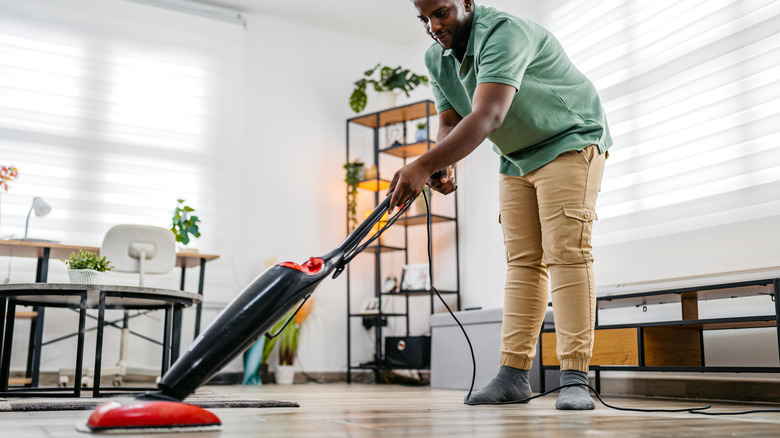Dust Vs Mold: How To Tell Which One Is In Your Home (And How To Get Rid Of Both)
Dust and mold are two different substances everyone should keep tabs on in their home. Not only can accumulating dust and mold growth be unsightly and cause damage in some cases, but they can also both become dangerous to your health. Dust is associated with numerous hidden hazards, including allergy problems and respiratory issues, such as asthma, while long-term mold exposure is linked with skin and eye irritation, flu-like symptoms, and worsen preexisting asthma (via the National Center for Healthy Housing). If you are concerned about whether you have a dust or mold problem in your home, you can identify it by its appearance, as well as where it is located.
Dust is usually gray-colored, and it has a dry, powder-like texture. You're more likely to find dust in dry surfaces of your home, such as non-upholstered furniture, door frames, and windowsills, but it can also accumulate on fabric surfaces, such as mattresses, carpets, and upholstered furniture. Mold, on the other hand, is made of fungi, so it's more likely to be found in damp, warm, and humid areas of your home. These include showers, around faucets, and any item that gets wet, such as drywall, beneath sinks, or underneath flooring materials. Mold also ranges in color from gray or green, to brown or black.
How to control dust in your home
Dust is composed of a variety of organic products, and can be found both indoors and outdoors. The dust that's inside your home can be made from a combination of dirt that's brought in from outside, as well as dead skin cells, animal dander, and dust mite matter. Due to its composition, it's normal to have a small amount of dust in your home. However, controlling dust that comes inside your home from the outdoors is an important step to control potential sources of allergens. It's equally important to remove dust in your home and prevent it from accumulating to large levels so you can reduce its impacts on your health.
The National Center for Healthy Housing (NCHH) estimates that two-thirds of all dust in your home comes in from the outdoors. As such, you can reduce the chances of dust being tracked in by removing shoes at the door and placing door mats to trap outdoor particles. For dust that is already in your home, regular cleaning and vacuuming are key to managing it. A vacuum with a HEPA filter can be more effective in trapping dust, and you may need to clean carpeting and rugs more often as particles may cling to these fabrics. Also, having clean air filters in your HVAC system can reduce the amount of dust in the air. Dusters and damp cloths can effectively remove dust in other areas, such as walls, furniture shelves, tables, curtains, and baseboards.
How to effectively remove mold from your home
Mold is made up of microscopic fungi, and can quickly spread if not treated in your home. According to the NCHH, at least 1,000 different types of mold can grow in homes, and these are usually found in damp spaces. While mold is natural in the outdoors and can have important environmental impacts, this type of fungi is not welcome within indoor spaces due to its health implications. Mold forms on damp and wet surfaces when small spores land on the area and then multiply.
The best way to prevent mold from growing in your home is to keep all surfaces dry. These include showers, bathtubs, and floors. If there is a leak or other source of water damage, these must be treated within 48 hours to prevent mold growth. When cleaning mold on contaminated surfaces, try a solution of vinegar and baking soda, or soap and water before scrubbing with a disposable rag. Always wear an N-95 mask when cleaning moldy spaces to reduce the chances of inhaling mold spores, and protect your skin by wearing gloves. You should also open a window to ventilate the space during cleaning. If you have a significant mold problem in your drywall or floors, consider contacting a professional for help.


